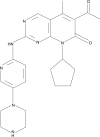Palbociclib: an evidence-based review of its potential in the treatment of breast cancer
- PMID: 25177151
- PMCID: PMC4128689
- DOI: 10.2147/BCTT.S46725
Palbociclib: an evidence-based review of its potential in the treatment of breast cancer
Abstract
Cellular proliferation, growth, and division following DNA (deoxyribonucleic acid) damage are tightly controlled by the cell-cycle regulatory machinery. This machinery includes cyclin-dependent kinases (CDKs) which complex with their cyclin partners, allowing the cell cycle to progress. The cell-cycle regulatory process plays a critical role in oncogenesis and in the development of therapeutic resistance; it is frequently disrupted in breast cancer, providing a rational target for therapeutic development. Palbociclib is a potent and selective inhibitor of CDK4 and -6 with significant activity in breast cancer models. Furthermore, it has been shown to significantly prolong progression-free survival when combined with letrozole in the management of estrogen receptor-positive metastatic breast cancer. In this article we review the cell cycle and its regulatory processes, their role in breast cancer, and the rationale for CDK inhibition in this disease. We describe the preclinical and clinical data relating to the activity of palbociclib in breast cancer and the plans for the future development of this agent.
Keywords: CDK4/6 inhibition; cell-cycle regulation; cyclin-dependent kinases.
Figures



Similar articles
-
Cyclin-dependent protein kinase inhibitors including palbociclib as anticancer drugs.Pharmacol Res. 2016 May;107:249-275. doi: 10.1016/j.phrs.2016.03.012. Epub 2016 Mar 16. Pharmacol Res. 2016. PMID: 26995305 Review.
-
Profile of palbociclib in the treatment of metastatic breast cancer.Breast Cancer (Dove Med Press). 2016 May 17;8:83-91. doi: 10.2147/BCTT.S83146. eCollection 2016. Breast Cancer (Dove Med Press). 2016. PMID: 27274308 Free PMC article. Review.
-
Clinical Management of Potential Toxicities and Drug Interactions Related to Cyclin-Dependent Kinase 4/6 Inhibitors in Breast Cancer: Practical Considerations and Recommendations.Oncologist. 2017 Sep;22(9):1039-1048. doi: 10.1634/theoncologist.2017-0142. Epub 2017 Jul 13. Oncologist. 2017. PMID: 28706010 Free PMC article. Review.
-
The cyclin-dependent kinase 4/6 inhibitor palbociclib in combination with letrozole versus letrozole alone as first-line treatment of oestrogen receptor-positive, HER2-negative, advanced breast cancer (PALOMA-1/TRIO-18): a randomised phase 2 study.Lancet Oncol. 2015 Jan;16(1):25-35. doi: 10.1016/S1470-2045(14)71159-3. Epub 2014 Dec 16. Lancet Oncol. 2015. PMID: 25524798 Clinical Trial.
-
A current and comprehensive review of cyclin-dependent kinase inhibitors for the treatment of metastatic breast cancer.Curr Med Res Opin. 2017 Sep;33(9):1559-1569. doi: 10.1080/03007995.2017.1348344. Epub 2017 Jul 25. Curr Med Res Opin. 2017. PMID: 28657360 Review.
Cited by
-
Insights on Structural Characteristics and Ligand Binding Mechanisms of CDK2.Int J Mol Sci. 2015 Apr 24;16(5):9314-40. doi: 10.3390/ijms16059314. Int J Mol Sci. 2015. PMID: 25918937 Free PMC article. Review.
-
RB1: a prototype tumor suppressor and an enigma.Genes Dev. 2016 Jul 1;30(13):1492-502. doi: 10.1101/gad.282145.116. Genes Dev. 2016. PMID: 27401552 Free PMC article. Review.
-
Insights into the Peritumoural Brain Zone of Glioblastoma: CDK4 and EXT2 May Be Potential Drivers of Malignancy.Int J Mol Sci. 2023 Feb 2;24(3):2835. doi: 10.3390/ijms24032835. Int J Mol Sci. 2023. PMID: 36769158 Free PMC article.
-
Safety and efficacy profile of cyclin-dependent kinases 4/6 inhibitor palbociclib in cancer therapy: A meta-analysis of clinical trials.Cancer Med. 2019 Apr;8(4):1389-1400. doi: 10.1002/cam4.1970. Epub 2019 Mar 21. Cancer Med. 2019. PMID: 30897298 Free PMC article.
-
Palbociclib: A breakthrough in breast carcinoma in women.Med J Armed Forces India. 2016 Dec;72(Suppl 1):S37-S42. doi: 10.1016/j.mjafi.2015.11.002. Epub 2016 Jan 26. Med J Armed Forces India. 2016. PMID: 28050067 Free PMC article. Review.
References
-
- Weinberg RA. The Biology of Cancer. 2nd ed. New York: Garland Science; 2014.
-
- Weinberg RA. The retinoblastoma protein and cell cycle control. Cell. 1995;81(3):323–330. - PubMed
Publication types
LinkOut - more resources
Full Text Sources
Other Literature Sources

